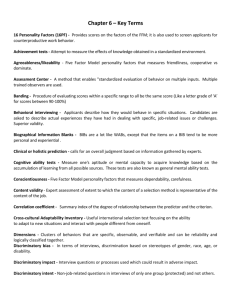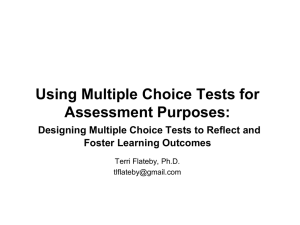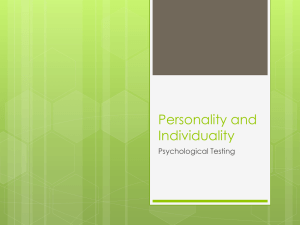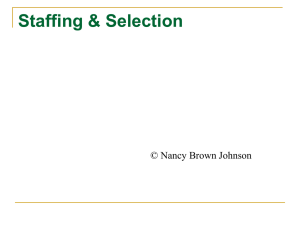Chapter_009
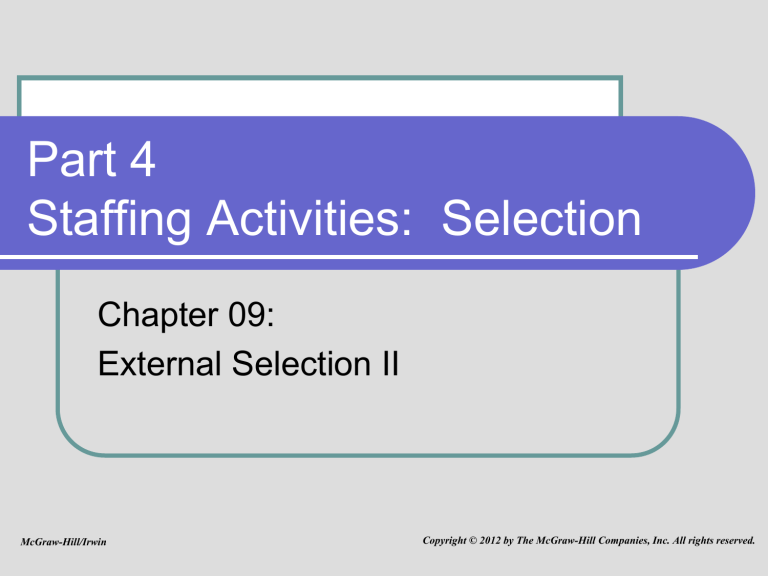
Part 4
Staffing Activities: Selection
Chapter 09:
External Selection II
Copyright © 2012 by The McGraw-Hill Companies, Inc. All rights reserved.
McGraw-Hill/Irwin
Staffing Organizations Model
Organization
Mission
Goals and Objectives
Organization Strategy HR and Staffing Strategy
Staffing Policies and Programs
Support Activities Core Staffing Activities
Legal compliance
Planning
Job analysis
Recruitment: External, internal
Selection:
Measurement, external, internal
Employment:
Decision making, final match
Staffing System and Retention Management
9-2
External Selection II Outline
Substantive Assessment
Methods
Personality Tests
Ability Tests
Emotional Intelligence
Tests
Performance Tests and
Work Samples
Situational Judgment
Tests
Integrity Tests
Interest, Values, and
Preference Inventories
Structured Interview
Choice of Substantive
Assessment Methods
Discretionary Assessment
Methods
Contingent Assessment
Methods
Drug testing
Medical exams
Legal Issues
Uniform Guidelines on
Employee Selection
Procedures
Selection Under the
Americans With
Disabilities Act (ADA)
Drug Testing
9-3
Learning Objectives for This Chapter
Distinguish among initial, substantive, and contingent selection
Review the advantages and disadvantages of personality and cognitive ability tests
Compare and contrast work sample and situational judgment tests
Understand the advantages of structured interviews and how interviews can be structured
Review the logic behind contingent assessment methods and how they are administrated
Understand the ways in which substantive and contingent assessment methods are subject to various legal rules and restrictions
9-4
Discussion Questions for This Chapter
Describe the similarities and differences between personality tests and integrity tests. When is each warranted in the selection process?
How would you advise an organization considering adopting a cognitive ability test for selection?
Describe the structured interview. What are the characteristics of structured interviews that improve on the shortcomings of unstructured interviews?
What are the most common discretionary and contingent assessment methods? What are the similarities and differences between the use of these two methods?
How should organizations apply the general principles of the
UGESP to practical selection decisions?
9-5
Ex. 8.3 Assessment
Methods by Applicant
Flow Stage
•Substantive assessment methods
•Determining who among the minimally qualified will likely be the best performers on the job
9-6
Overview of Personality Tests
Current role of personality tests e.g., role of Big Five
Describe behavioral, not emotional or cognitive traits
May capture up to 75% of an individual’s personality
Big Five factors (Personality Characteristics Inventory etc.)
Emotional stability-calm, optimistic, and well adjusted
Extraversion-sociable, assertive, active, upbeat, and talkative
Openness to experience-imaginative, attentive to inner feelings, have intellectual curiosity and independence of judgment
Agreeableness-altruistic, trusting, sympathetic, and cooperative
Conscientiousness-purposeful, determined, dependable, and attentive to detail
Roughly 50% of the variance in the Big Five traits appears to be inherited
9-7
Measures of Personality Tests
Surveys
Personal Characteristics Inventory (PCI)
NEO Personality Inventory
Hogan Personality Inventory (HPI)
Administration options
Paper-and-pencil
Interviews
Online forms
9-8
Ex. 9.1 Sample Items from the
Personal Characteristics Inventory
Conscientiousness
I can always be counted on to get the job done.
I am a very persistent worker.
I almost always plan things in advance of work.
Extraversion
Meeting new people is enjoyable to me.
I like to stir up excitement if things get boring.
I am a “take-charge” type of person.
9-9
Ex. 9.1 Sample Items from the
Personal Characteristics Inventory
Agreeableness
I like to help others who are down on their luck.
I usually see the good side of people.
I forgive others easily.
Emotional Stability
I can become annoyed at people quite easily (reversescored).
At times I don’t care about much of anything (reverse-scored).
My feelings tend to be easily hurt (reverse-scored).
Openness to Experience
I like to work with difficult concepts and ideas.
I enjoy trying new and different things.
I tend to enjoy art, music, or literature.
9-10
Ex. 9.2 Implications of Big Five
Personality Traits at Work
9-11
Criticisms of Personality Tests
Trivial validities
Correlations for any individual trait with job performance are typically low (around r=.23)
However, when all traits are used simultaneously, correlations are higher
Faking
Individuals answer in a dishonest way
However, tests still have some validity, and it may be that being able to “act” conscientiously may be related to real job performance
Negative applicant reactions
Applicants, in general, believe personality tests are less valid predictors of job performance
9-12
Exhibit 9.3 The Core Self-
Evaluations Scale
9-13
Overview of Ability Tests
Definition -- Measures that assess an individual’s capacity to function in a certain way
15 to 20% of organizations use ability tests in selection
Two types
Aptitude - Assess innate capacity to function
Achievement - Assess learned capacity to function
9-14
Overview of Ability Tests
Four classes of ability tests
Cognitive: perception, memory, reasoning, verbal, math, expression
Psychomotor: thought/body movement coordination
Physical: strength, endurance, movement quality
Sensory/perceptual: detection & recognition of stimuli
9-15
Exhibit 9.4 Sample Cognitive Ability
Test Items
9-16
Evaluation of Cognitive Ability Tests
Validity approaches .50
Research findings
Among the most valid methods of selection
Often generalizes across organizations, job types, and types of applicants
Can produce large economic gains for organizations and provide major competitive advantage
Validity is particularly high for jobs of medium and high complexity but also exists for simple jobs
A simple explanation for validity: those with higher cognitive ability acquire and use greater knowledge
9-17
Limitations of Cognitive Ability Tests
Concern over adverse impact and fairness of tests
Equally accurate predictors of job performance for various racial & ethnic groups
Blacks and Hispanics score lower than whites
This gap is narrowing somewhat over time
Alternative presentation formats (e.g., verbal tests) decrease differences in scores dramatically while producing nearly equivalent scores
Applicants’ perceptions
Reactions to concrete vs. abstract test items
9-18
Other Types of Ability Tests
Psychomotor ability tests
Reaction time, arm-hand steadiness, control precision, and manual and digit dexterity
Physical abilities tests
Muscular strength, cardiovascular endurance, and movement quality
Sensory/perceptual abilities tests
Ability to detect and recognize environmental stimuli
Note: Increasingly, ability tests are being computer administered
9-19
Emotional Intelligence
The ability to monitor one’s own and others’ feelings, to discriminate among them, and to use this information to guide one’s thinking and action
Self-awareness: Good at recognizing and understanding one’s own emotions
Other awareness: Good at recognizing and understanding others’ emotions
Emotion regulation: Good at making use of or managing this awareness
9-20
Emotional Intelligence
A review of 59 studies indicated that, overall, EI correlated moderately with job performance
Some critics argue that because EI is so closely related to intelligence and personality, once you control for these factors, EI has nothing unique to offer
Still not clear whether these tests are useful
9-21
Performance Tests and Work Samples
Definition -- Assess actual performance (e.g., fix a car, teach a class, type a document)
Types of tests (should focus on relevant
KSAOs)
Performance test vs. work sample (all or some)
Motor vs verbal work samples (action or thought)
High- vs. low-fidelity tests (level of realism)
Computer interaction performance tests vs. paperand-pencil tests including simulations (e.g., The
Manager’s Workshop)
All the above can have good validity (.50+) & acceptance
9-22
Situational Judgment Tests
Place applicants in hypothetical, jobrelated situations.
Applicants are then asked to choose a course of action from several alternatives
Capture the validity of work samples and cognitive ability tests in a way that is cheaper than work samples and that has less adverse impact than cognitive ability tests
9-23
Ex. 9.7: Example of Situational
Judgment Test Item
9-24
Integrity Tests
Two types (Exhibit 9.9)
Clear purpose / overt
Do you think most people would cheat if they thought they could get away with it?
Do you believe a person has a right to steal from an employer if he or she is unfairly treated?
Personality-based/veiled purpose
Would you rather go to a party than read a newspaper?
How often do you blush?
Scores appear to reflect conscientiousness, agreeableness, and emotional stability
9-25
Integrity Tests
Validity can be useful
Clear purpose as high as .55 predicting bad behaviors
General purpose as high as .32 predicting bad behaviors
Can predict performance as well (as high as
.30)
Why would these predict general performance?
9-26
Interest, Values, and Preference
Inventories
Assess activities individuals prefer to do on & off the job; do not attempt to assess ability to do these
Not often used in selection
Can be useful for self-selection into job types
Types of tests
Strong Vocational Interest Blank (SVIB)
Myers-Briggs Type Inventory (MBTI)
Evaluation
Unlikely to predict job performance directly
May help assess person-organization fit & subsequent job satisfaction, commitment & turnover
9-27
Discussion questions
Describe the similarities and differences between personality tests and integrity tests. When is each warranted in the selection process?
How would you advise an organization considering adopting a cognitive ability test for selection?
9-28
Typical Unstructured Interviews
Relatively unplanned and “quick and dirty”
Questions based on interviewer “hunches” or
“pet questions” to assess applicants
Casual, open-ended, or subjective questions
Often contains obtuse questions
Often contains highly speculative questions
Interviewer often unprepared
More potential for discrimination and bias
Validity typically r=.20
9-29
Structured Interviews
Questions based on job analysis
Same questions asked of each candidate
Response to each question numerically evaluated
Detailed anchored rating scales used to score each response
Detailed notes taken, focusing on interviewees’ behaviors
Validity may be r=.30 or better
Surprisingly uncommon in organizations
9-30
Structured Interviews (continued)
Situational - Assess applicant’s ability to project his / her behaviors to future situations. Assumes the person’s goals/intentions will predict future behavior
Experience-based -
Assess past behaviors that are linked to prospective job.
Assumes past performance will predict future performance
Research is inconclusive regarding which type is best
Individual interviews usually more valid than panel interviews
9-31
Constructing a Structured Interview
Consult job requirements matrix
Develop the selection plan
Exh. 9.10: Partial Selection Plan for Job of Retail
Store Sales Associate
Develop structured interview plan
Exh. 9.11: Structured Interview Questions,
Benchmark Responses, Rating Scale, and
Question Weights
Select and train interviewers
Evaluate effectiveness
9-32
Discussion questions
Describe the structured interview. What are the characteristics of structured interviews that improve on the shortcomings of unstructured interviews?
9-33
Selection for Team Environments
Types of teams
Problem-solving teams
Self-managed work teams
Cross-functional teams
Virtual teams
Establish steps for selection in team-based environments
Who should make the hiring decision?
Critical to ensure proper context is in place
9-34
Selection for Team Environments
Interpersonal KSAs
Conflict-Resolution KSAs
Collaborative Problem-Solving KSAs
Communication KSAs
Self-management KSAs
Goal-Setting and Performance Management
KSAs
Planning and Task-Coordination KSAs
9-35
Exhibit 9.14 Evaluation of
Substantive Assessment Methods
9-36
Discretionary Assessment
Methods
Used to separate people who receive job offers from list of finalists (assumes each finalist is considered fully qualified for position)
Often very subjective, relying heavily on intuition of decision maker
Factors other than KSAOs are evaluated
Assess person/organization match
Assess motivation level
Assess people on relevant organizational citizenship behaviors
Should involve organization’s staffing philosophy regarding EEO/AA commitments
9-37
Contingent Assessment Methods
“We offer you this job contingent upon
….”
Contingent methods not always used
Depends on nature of job and legal mandates
Might involve confirmation of
Drug test results
Medical exam results
9-38
Drug Testing
The average drug user
was 3.6 times more likely to be involved in an accident
received 3 times the average level of sick benefits was 5 times more likely to file a workers’ compensation claim
missed 10 times as many work days as nonusers
31% of all fatal truck accidents were due to alcohol or drugs
Drug testing has decreased in recent years because so few people test positive
9-39
Ex. 9.16
Example of a Drug Testing Program
9-40
Features of an effective drug testing program
Emphasize drug testing in safety-sensitive jobs
Use only reputable testing laboratories, and ensure that strict chain of custody is maintained.
Ask applicants for their consent, and inform them of test results
Use retesting to validate positive samples from the initial screening test
Ensure that proper procedures are followed to maintain the applicant’s right to privacy
Review the program and validate the results against relevant criteria (accidents, absenteeism, turnover, job performance); conduct a cost-benefit analysis
9-41
Medical Exams
Identify potential health risks in job candidates
Must ensure medical exams are required only when a compelling reason exists
Ensures people with disabilities unrelated to job performance are not screened out
Use is strictly regulated by ADA to ensure disabilities not job related are not screened out
Usually lack validity as procedures vary by doctor
Not always job related
Often emphasize short- rather than long-term health
New job-related medical standards are specific, job related, and valid
9-42
Discussion questions
What are the most common discretionary and contingent assessment methods?
What are the similarities and differences between the use of these two methods?
9-43
Legal Issues: Uniform Guidelines on
Employee Selection Procedures (UGESP)
General principles
Technical standards
Documentation of impact and validity evidence
Definitions
Makes substantial demands of a staffing system
Ensures awareness of possibility of adverse impact in employment decisions
If adverse impact is found, mechanisms provided to cope with it
9-44
Legal Issues: ADA and Drug Testing
Selection under the Americans with Disabilities
Act (ADA)
General principles
Access to job application process
Reasonable accommodation to testing
Medical examinations
Drug testing
UGESP
Drug testing is permitted to detect illegal drug use and discipline/termination if found is OK
9-45
Medical Exams
Identifies potential health risks in job candidates
Important to ensure medical exams are required only when a compelling reason exists
Ensures people with disabilities unrelated to job performance are not screened out
Use is strictly regulated by ADA
Lack validity as procedures vary by doctor
Not always job related
Often emphasizes short- rather than long-term health
New approach -- Job-related medical standards
9-46
Discussion questions
How should organizations apply the general principles of the UGESP to practical selection decisions?
9-47
Ethical Issues
Issue 1
Do you think it’s ethical for employers to select applicants on the basis of questions such as,
“Dislike loud music” and “Enjoy wild flights of fantasy,” even if the scales that such items measure have been shown to predict job performance? Explain.
Issue 2
Cognitive ability tests are one of the best predictors of job performance, yet they have substantial adverse impact against minorities. Do you think it’s fair to use such tests? Why or why not?
9-48
